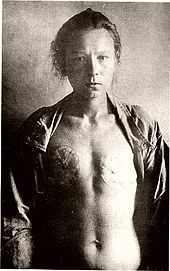Mastectomy
Mastectomy (from the Greek μαστός 'breast' , έκ 'out' and τομή 'cut') is the surgical removal of breast tissue and describes the complete or partial removal of the female or male mammary gland or the mammary gland in other mammals . In some forms of mastectomy, the areola is retained with the nipple , making the resulting breast appear like a male.
Mastectomy is also often synonymous with mammae ablation , breast amputation or mastectomies , the removal of the entire breast , used, although the latter two always a complete removal of the breast including the nipple include, which is not true in all types of mastectomy.
If only a small tumor is removed to conserve the breast, it is called a lumpectomy or quadrantectomy (partial mastectomy).

Indications
A mastectomy can be performed for the following indications :
- For malignant breast diseases in women or men or breast tumors in animals,
- with very large breasts ( hypermastia in women or gynecomastia in men)
- in some large benign breast tumors in women or men
- as a prophylactic mastectomy in women with a high familial breast cancer risk (for example, if there is a BRCA1 or BRCA2 mutation), then even on both sides
- as a gender reassignment surgery on trans men
Depending on many factors, very different techniques with justifiable different results are used. In gynecomastia, the outcome of the operation is optimal when an outside observer cannot see the consequences of the operation.
Forms of mastectomy
One differentiates:
- (Subcutaneous) mastectomy refers to the removal of the mammary gland without skin, nipples and areola. In women, if no breast reconstruction is performed, a male breast results .
- Simple mastectomy refers to the removal of the breast, including a skin spindle with the nipple , fatty tissue, and fascia of the pectoral muscle .
- Modified radical mastectomy includes, in addition to simple ablation, the removal of lymph tissue and lymph nodes in the armpit and is mainly used for breast cancer.
- Radical mastectomy (syn. Rotter - Halsted operation) also includes removal of the large pectoral muscle . This surgical technique is almost no longer used today.
- Reduction mastectomy (syn. Reduction plastic) is a cosmetic operation to reduce the size of one or both breasts.
A mastectomy for cosmetic reasons is often divided into two operations that are carried out six to twelve months apart , especially for large breasts, but never for malignant tumors . Usually only small corrections are necessary. The length of stay in hospital is between three and ten days.
Breast restoration
Since a mastectomy for medical reasons (e.g. breast cancer) is a serious intervention in the body image and thus in the psyche of the women concerned, a surgical breast replacement on a biological or artificial basis is usually offered or advice is given for the lost tissue when adapting a replacement. There are three options:
Breast implants
These are known from breast enlargement and mostly consist of molded cushions filled with silicone gel or table salt, which are inserted either directly under the skin or under the large pectoral muscle.
Flap sculptures
During these plastic operations, tissue (skin and fat, possibly also muscle tissue) from other regions of the body (usually the abdomen or back) is transferred to the chest and formed into a new breast there. This method is particularly preferred by young patients.
Breast epitheses
Breast epitheses (or prostheses ) are also shaped pillows that mimic the shape and weight of the normal breast. They are either placed loosely in the bra cup or affixed to the chest wall by means of an adhesive strip on a contact surface.
Mastectomy for religious reasons
In the case of the Skopzen , a sect widespread in Russia in the 19th century , the genitals of both sexes and the breasts of the female members were also removed. This should ensure that no physical desire misleads the members of the religious community.
See also
literature
- Siddhartha Mukherjee: The Emperor of All Maladies: A Biography of Cancer . Scribner, 2010, ISBN 1-4391-0795-5 , limited preview in Google Book Search.
- German edition: The king of all diseases . Translated from the English by Barbara Schaden. With a foreword by Fritz Pleitgen . DuMont, Cologne 2012, ISBN 978-3-8321-9644-8 . (Detailed description of the history of radical mastectomy in Chapter 2.)
- Pschyrembel Clinical Dictionary. Founded by Willibald Pschyrembel. Edited by the publisher's dictionary editor. 255th edition. De Gruyter, Berlin 1986 ( mastectomy ).
- Lois Jovanovic, Genell J. Subak-Sharpe: Hormones. The medical manual for women. (Original edition: Hormones. The Woman's Answerbook. Atheneum, New York 1987) From the American by Margaret Auer, Kabel, Hamburg 1989, ISBN 3-8225-0100-X , pp. 252-256 and 380.
Individual evidence
- ↑ a b c S. Reefy et al. a .: Oncological outcome and patient satisfaction with skin-sparing mastectomy and immediate breast reconstruction: a prospective observational study. In: BMC Cancer 2010, 10: 171 doi: 10.1186 / 1471-2407-10-171 ( Open Access , under CC-by-2.0)
- ^ Marion Kiechle, Rita Katharina Schmutzler, Matthias Wilhelm Beckmann: Prevention: Familial breast and ovarian carcinoma . In: Deutsches Ärzteblatt . tape 99 , no. 20 . Deutscher Ärzte-Verlag , May 17, 2002, p. A-1372 / B-1146 / C-1071 .



